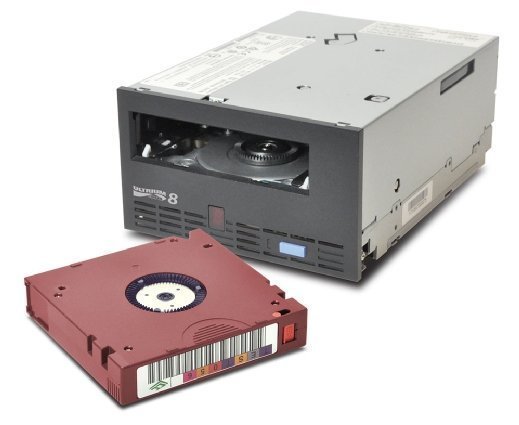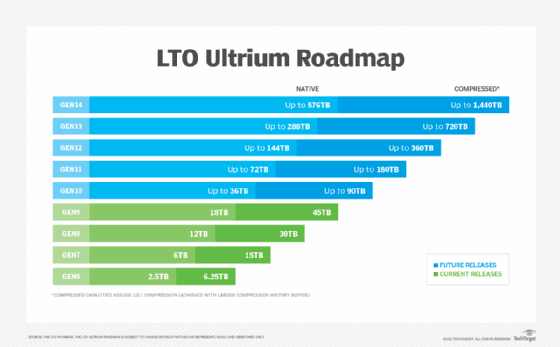LTO-8 (Linear Tape-Open 8) (original) (raw)
LTO-8, or Linear Tape-Open 8, is a tape format from the Linear Tape-Open Consortium released in late 2017. It succeeded the LTO-7 version, which launched in 2015.
An LTO-8 cartridge offers 30 terabytes of compressed storage capacity and 12 TB of uncompressed capacity. Sustained data transfer rates are 750 megabytes per second for compressed data and 360 MBps for uncompressed data. LTO-8 -- as with LTO-5, LTO-6 and LTO-7 formats -- offers partitioning, encryption and the write once, read many (WORM) feature. LTO-8 tape drives are backward compatible to one generation, so they can read and write to LTO-7 tapes.
LTO is an open format magnetic tape technology developed and updated by Hewlett Packard Enterprise (HPE), IBM and Quantum -- the members of the LTO Consortium.
LTO is often referred to as the LTO Ultrium format. Ultrium is fundamentally the trade name for LTO. However, today this and other elements of magnetic tape technology are collectively referred to simply as LTO.
Important features of LTO-8
LTO-8 uses tunnel magnetoresistance (TMR) for tape heads, a switch from the previous giant magnetoresistance (GMR). TMR provides a more defined electrical signal than GMR, allowing bits to be written to smaller areas of LTO media. The LTO-8 tape head with TMR enables higher density, lower susceptibility to media discrepancies, cooler temperatures and better signal sensitivity, according to vendor Spectra Logic. TMR was developed because GMR heads had reached their density limit.
LTO-8 also uses barium ferrite instead of metal particles for capacity improvement. Barium ferrite -- a type of magnetic particle -- can be reduced in size to improve recording density without magnetic signal loss.
New versions of LTO have traditionally been able to read back two generations and write back to one generation. For example, LTO-7 drives could read LTO-5 and LTO-6 cartridges and write to LTO-6. With LTO-8, the inclusion of TMR technology and barium ferrite limits backward compatibility to one generation. As a result, LTO-8 can read and write to LTO-7.

The LTO-8 tape format was released in late 2017 by members of the LTO Consortium.
As with previous generations, LTO-8 features the WORM capability, the Linear Tape File System (LTFS) and encryption. By allowing users to write to the tape only once, WORM ensures data isn't overwritten and helps with compliance. Through LTFS, the tapes offer partitioning, which tells the LTO tape drive exactly where a file is stored and improves file control and space management. And the 256-bit Advanced Encryption Standard (AES) enhances security and privacy when tapes are stored and shipped.
Tape is a strong choice when data storage security is a concern to counter ransomware and other cyberattacks. It offers offline data protection, keeping data isolated from networks susceptible to viruses.
LTO-8 supports up to four partitions and has a reliability of a 10-19 bit error rate.
LTO-8 tape capacity
Two of the biggest benefits of tape storage are capacity and its distinct product roadmap. LTO's roadmap has the technology essentially doubling tape storage capacity with each new generation. Capacity is a key element of storage now that even small businesses handle data at the hundreds of terabytes or even petabyte (PB) levels.
The 12 TB of uncompressed capacity featured in LTO-8 is equivalent to 8,000 movies, 2,880,000 songs or 7,140,000 photos, according to Spectra Logic. In the last 10 years, LTO has increased capacity by 1,400%.
The LTO Program introduced a new feature with LTO-8: The drive can write 9 TB uncompressed on a new LTO-7 cartridge, instead of the typical 6 TB. That medium is labeled an "LTO-7 initialized LTO-8 Type M cartridge," according to the LTO Program. Only new LTO-7 cartridges can be initialized as LTO-8 Type M. The initialized cartridge can only be read and written to in an LTO-8 drive. It offers 22.5 TB of compressed capacity.
LTO-8 vs. LTO-7
LTO-8 doubled the capacity of LTO-7, from 6 TB to 12 TB uncompressed and 15 TB to 30 TB compressed. The capacity compression ratio of 2.5-1 is the same. They also have the same number of channels at 32.
LTO-8 features a performance increase from 300 MBps to 360 MBps for the uncompressed data transfer rate and from 700 MBps to 750 MBps compressed. Industry experts have said LTO-7 might be the last iteration catering to small and medium-sized customers, given its lower price point.
LTO-7 drives can read LTO-6 and LTO-5 cartridges and write back to LTO-6, while LTO-8 can only read and write back to LTO-7.
LTO-8 vs. LTO-9
LTO-9 increased the capacity of LTO-8 from 12 TB to 18 TB uncompressed and from 30 TB to 45 TB compressed. As with previous LTO versions, LTO-9 continues with a 2.5-1 compression ratio and can write data over 32 channels.
LTO-9 further increases the tape performance from 360 MBps to 400 MBps for uncompressed data, and from 750 MBps to 1,000 MBps for compressed data.
LTO-9 drives can read and write back to LTO-8 media. This compatibility is similar to LTO-8, but it represents a shift from LTO-1 through LTO-7, which can read from tapes two generations prior, in addition to writing to tapes one generation prior.
LTO tape roadmap and future directions
LTO Ultrium tape technology was first introduced in 2000 and has continued to advance through a series of new iterations appearing every few years, including the following nine:
- LTO-1, released in 2000, was the first version of the LTO technology to serve as an open standard substitute to the available formats of the day. It has native capacity of 100 gigabytes (GB) and a native transfer speed of 20 MBps.
- LTO-2, released in 2003, offered 200 GB capacity (400 GB compressed) with 40 MBps throughput (80 MBps compressed). It doubled the speed and capacity of LTO-1. Capacity and data transfer rates for LTO-2 assume a 2-1 compression ratio.
- LTO-3, released in 2005, doubled native capacity to 400 GB (800 GB compressed) and transfer rates to 80 MBps (160 MBps compressed). It was the first LTO format to feature WORM.
- LTO-4, released in 2007, again doubled native capacity to 800 GB (1.6 TB compressed) and boosted transfer rates to 120 MBps (240 MBps compressed). LTO-4 also included 256-bit AES-Galois/Counter Mode drive-level encryption.
- LTO-5, released in 2010, boosted native capacity to 1.5 TB (3 TB compressed) and data transfer rates to 140 MBps (280 MBps compressed), with a 2-1 compression ratio. The standard also added partitioning.
- LTO-6, released in 2012, featured 2.5 TB native capacity (6.25 TB compressed), with native sustained data transfer rates as high as 160 MBps (400 MBps compressed).
- LTO-7, released in 2015, provided 6 TB of uncompressed capacity (15 TB compressed) and data transfer rates up to 300 MBps uncompressed (700 MBps compressed), with 2.5-1 compression and up to four partitions.
- LTO-8, released in 2017, offered up to 12 TB of uncompressed capacity (30 TB compressed) and data transfer rates up to 360 MBps uncompressed (750 MBps compressed). It maintains 2.5-1 compression and up to four partitions.
- LTO-9, released in 2021, has up to 18 TB of uncompressed capacity (45 TB compressed) and can deliver data transfer rates of 400 MBps uncompressed (up to 1,000 MBps compressed). It also provides 2.5-1 compression ratios and support for up to four partitions.

Of the LTO Consortium's 14 LTO iterations, LTO-9 is the latest version currently available.
The LTO Consortium currently has 14 LTO iterations in its overall roadmap, with LTO-9 now in the marketplace. Future iterations are expected to include LTO-10 through LTO-14, presuming current naming conventions are maintained.
Moving forward, each new LTO iteration is expected to double the uncompressed and compressed storage capacity over the previous iteration, while increasing data transfer rates as technology allows. The 2.5-1 compression ratio is expected to be preserved throughout the LTO roadmap, and well-established features including LTFS, WORM, partitioning and encryption should also be present.
The planned 1,440 TB compressed capacity of LTO-14 will be 48 times greater than the 30 TB compressed capacity of LTO-8.
In the past, users would often skip an LTO generation when upgrading, as the increase in capacity wasn't big enough to encourage a change to the next LTO format. For example, moving from LTO-5 to LTO-6 increased the uncompressed capacity by only 1 TB. Now, each new LTO release has a large enough capacity increase to warrant an immediate upgrade.
In addition, starting with LTO-8, tape drives are only able to read back one generation versus the previous two. This, too, encourages organizations to upgrade faster.
However, any decision to upgrade must include consideration of both backward LTO cartridge compatibility and long-term data storage obligations. Because LTO-8 and future LTO iterations can only interoperate with one previous LTO generation, it's possible for tape drives to be upgraded beyond their ability to read older tapes. This situation could render long-term archival tape data inaccessible.
What tape is used for
Magnetic tape is exceeded only by punched paper as the oldest and longest-serving form of storage medium found for digital environments. Tape once served as mainline storage, letting computers of the day save and load programs and data in much the same way that current systems rely on magnetic hard drives. Classic reel-to-reel systems were reimagined as self-contained cartridge systems, and the LTO standard represents just one of many tape data cartridges.
As hard disk drives permeated computer technology, tape was relegated to a secondary role as a backup storage medium; HDDs held programs and data, and backup copies were made periodically to tape. If an HDD failed, the latest available copy could be restored from tape. In addition, tape cartridges are highly self-contained and mobile, and well-suited for off-site disaster recovery storage technology.
Still, the growth of data protection technologies such as continuous data protection and data backup targets -- like software as a service and public cloud providers -- has further marginalized tape technologies to long-term, high-volume archival tasks. Tape is often used by industries such as media, entertainment and the sciences, which can create large volumes of data daily and need a storage medium that's less expensive than disk.
Pros and cons of tape
Tape technology has fallen into disuse because its advantages are outstripped by its limitations. However, it's still the go-to option for a few remaining niche tasks, such as data-heavy audio and video data storage. Tape does offer some noteworthy functionality and benefits, including the following:
- Long life. Magnetic tape typically suffers from low endurance -- it can't be rewritten countless times like HDDs and solid-state drives (SSDs). However, because it's rarely used, a properly written, validated, stored tape cartridge can remain valid for decades. Businesses that demand high-volume, long-term storage might find tapes useful.
- Good mobility. Tape cartridges are inherently mobile, relying on a shell to shield the tape within from dust, debris and light physical shock. Tapes have long been used for off-site storage, letting businesses easily separate backup and disaster recovery data from actual facilities and providing an added level of physical protection.
- Natural security. Once a tape cartridge is removed from a tape drive, the data on the cartridge has a high level of natural security. It can't be altered or hacked, and its data is often recorded with encryption.
- Low cost. Although tape drives can be a costly investment, the actual tape cartridges -- the storage media -- are relatively cheap, allowing vast storage at an economical price point.
Despite these advantages, businesses are left to consider the potential disadvantages of tape:
- Linear storage. Tape is a linear medium. An entire tape, such as the entire backup session, typically must be read and restored. This is extremely slow and inefficient compared with HDDs and SSDs, which feature random access. While it is possible to create searchable backups with tape, those tapes then must be searched to find the data content to be restored.
- Physical security. The convenient mobility of tape is tempered by the vulnerability of tape cartridges to theft and physical damage. A stolen tape with unencrypted data can be just as devastating to a business as a hack of its online data set. Tapes must be secured against theft and stored in a temperature- and humidity-controlled environment to ensure their optimum retention life.
- Compatibility. Modern tape's long life span is useless if there's no working drive available to read the cartridge. This means a business must consider its tape strategy carefully, and tape drive technology refreshes will need to interoperate with existing, older tape cartridges. This can be problematic when tape standards evolve every few years, but tape cartridges might be kept for decades, depending on the organization's data retention policy.
- Retention uncertainty. Tape is only useful if its contents can be restored, but a tape cartridge removed from a drive and secured in an off-site location can't be tested at intervals to ensure the data is intact. This creates an undesirable cone of uncertainty about the reliability of long-term backup data.
What is a tape library?
A large business might require many tape drives to get the storage it needs. Organizations can vastly increase the capacity of a tape storage system by using a tape library.
A tape library is a collection of cartridges and drives. A typical library contains multiple drives for reading and writing data, access ports for entering and removing tapes, barcodes for tracking, and a device for mounting and dismounting cartridges. A library can include hundreds or thousands of tapes, providing high-capacity storage.
A tape library must be compatible with the rest of an organization's data protection platform, including its backup software. Organizations of all sizes use tape libraries. An enterprise will often use a tape library as a secondary backup or an archive, if not as a primary backup.
When fully populated with LTO-8 drives and LTO tape media, Spectra Logic's libraries will support at least 1 PB of compressed storage capacity. The Quantum LTO 3U scalable library can house 300 TB uncompressed -- and at least 600 TB compressed -- of LTO-8 tape storage for backup, archive and other secondary uses, according to industry experts. LTO-9 tape drives are now commonly deployed in many tape systems and libraries with even greater capacity.
Besides Quantum and Spectra Logic, Straits Research identified the following companies as key players in the North American tape storage market: Dell Technologies, HPE, IBM, Lenovo, Overland-Tandberg, QStar Technologies and Qualstar.
Learn what's behind the resurgence in tape use and how it might be useful to your organization.
This was last updated in May 2024
Continue Reading About LTO-8 (Linear Tape-Open 8)
- What the new LTO roadmap means for tape storage
- Future of tape backup built on consistent advancements
- Storage media showdown: The benefits of tape vs. disk backup
- Ways that backup has changed since the days of tape
- Long-term data backup options
 LTO-9 (Linear Tape-Open 9)
LTO-9 (Linear Tape-Open 9)  By: Paul Crocetti
By: Paul Crocetti  LTO-7 (Linear Tape-Open 7)
LTO-7 (Linear Tape-Open 7)  Linear Tape-Open (LTO)
Linear Tape-Open (LTO)  Fujifilm plans to ‘make tape easy’ with Kangaroo SME appliance
Fujifilm plans to ‘make tape easy’ with Kangaroo SME appliance  By: Antony Adshead
By: Antony Adshead